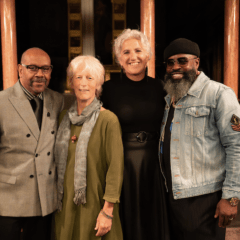Post by Andrea Kirsh

LEAH STEIN DANCE COMPANY members performing GATE at Eastern State Penitentiary, “Courtesy of Leah Stein Dance Company / Photographer: Digger
Vermont”–all photos in this post
Eastern State is the first and the most famous penitentiary in the world. When I first visited it, some fifteen years or so ago, I had to wear a hard hat for the private tour and I must say I despaired of the place surviving. It was a crumbling wreck only five blocks from the Philadelphia Museum of Art, and while it is now very pricey real estate, it didn’t seem ripe for Rouse Corporation adaptive re-use (as did Faneuil Hall in Boston, Union Station in St. Louis, and other significant pieces of historic American architecture co-opted for corporate use). I’m amazed and grateful that someone had the vision and ability to preserve it as the evocative ruin and important historical site that it is.
Leah Stein Dance Company has performed a series of works created for out-door environments since 2001, at locations from Longwood Gardens to an abandoned train station in Bytom, Poland as part of the Silesian International Dance Festival. In 2004 she began the series, “On Site Philadelphia,” with performances at significant locations around the city. Still, it was brave of Stein to take on a site as overburdened with memory as Eastern State; and this during a period when prisoners and disagreement over their treatment has been front-page news for months and is likely to remain so. Fortunately, she avoided narrative as well as any heavy-handed associations with current events. “Gate” is an ambitious collaboration among Stein and her dancers, the musicians Toshi Makahara (percussion) and Daniel Peterson (horns), and the visual artist, Edward Dormer.
The audience gathered just inside the prison gate and saw a figure in a blue shirt standing near the cell-block entrance, his back to us. After a short while two dancers, also facing away from the audience, appeared in the doorway and began a duet, moving in and out of the block, then using the steps and bannister as platform and barre. A third dancer (all of them dressed identically in dirty, rust-colored tee-shirts and khakis) appeared, and created a percussive accompaniment using bricks against the paved ground. More rust-shirted dancers joined them and all moved to the right, in an almost playful progression, rolling against and pushing away from cell-block walls. The audience followed them around the corner, while off to the right we saw several blue-shirted figures on benches in the courtyard, playing chess.
The group of dancers, joined by Makahara, continued to use the prison architecture as barriers, which they struggled against, as spaces which they delineated, and as a percussive instrument which they played with their feet and with various improvised instruments. While throughout the work the dancers enacted movements connoting cooperation, exertion, aggression, play, defeat, anxiety and other recognizable activities, the piece was essentially abstract. The blue-shirted figures, whom I came to think of as the shadow group of dancers, occasionally performed quotidian activities (playing chess, emptying a bucket of water), at other times appeared quietly in door-frames or observed the audience from outside through windows, and on one occasion played the somber music of gongs. While I was tempted to associate them with prison guards, their fleeting appearances in doors and through grime-y windows had stronger associations with the ghosts of prisoners.
The clearest reference to prison history was created by Edward Dormar’s interventions: he hung black drapes across selected cell doors as well as enlarged mug shots of prisoners. The program credited him with video as well, but I must have missed it. Frankly, the prison architecture was sufficient reminder of the building’s use, and I didn’t think the drapes and mug shots contributed much to the evening.
The most unexpected part of the performance was the manner in which Stein choreographed the audience as well as the dancers. We were assigned to one of four groups which divided once we rounded that first corner; we followed one pair of dancers or another to the signal of a colored program held aloft by a company member. For the hour-long piece we moved alternately as small groups through the individual blocks, then assembled as a company in the central hub of the prison; we separated into groups again, then met in the large yard at the back. We ultimately reassembled where we started, but facing outwards towards the gate, facing the street beyond.
I have no idea how the separated dancers kept track of time and each other, but all were extremely accomplished performers, and their activities were seamless. The most extensive musical section was with the group en mass in the yard at the back. Makihara played a percussion solo, then Peterson answered with his horn from one of the guard towers. The two also played in the finale, with Peterson at a distant but unidentified location. The music was remarkable and had an extraordinary, almost magical effect of articulating the spaces of the prison and its grounds.
Art events and installations at public sites are a particular challenge and often fail to meet the ambition of integrating site and artistic concept. Stein and her collaborators have created a work which more than justifies the risk. I can’t say I understood the reason for signing “Sweet Rosie O’Grady” as the blue-shirted group left the prison, but the power of the evening made me forget the ninety-three degree heat, and has added a richness to my associations with this historic site.
“Gate” will be performed again on June 15, 16 and 17. Performances begin in the early evening. Audience capacity is very limited; to reserve tickets, call (215) 438-2688.
–Andrea Kirsh is an art historian based in Philadelphia. You can read her newest Philadelphia Introductions and other commentary at InLiquid.










